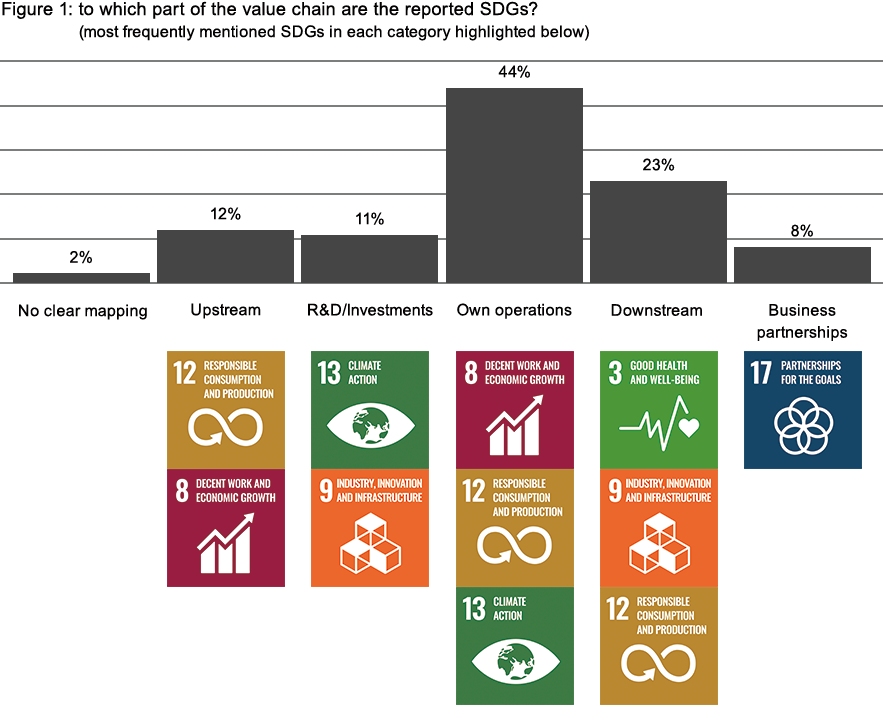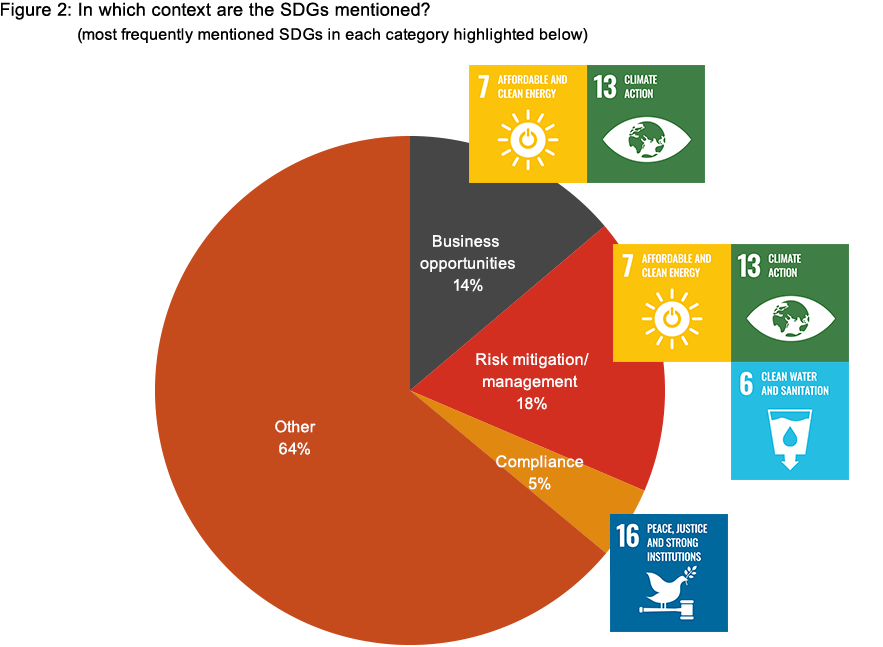
PwC SDG Reporting Challenge 2019 (Part 2)
2020-06-23
Putting the SDGs in context
To add depth and an extra level of analysis to the Japanese study we also analyzed in which contexts the SDGs are mentioned. By context, we mean A) where in the Value Chain companies see a connection to the SDGs, and B) if companies mainly see the SDGs as a source of opportunities, risks or perhaps just a “nice-to-have” which is not directly related to their core business.
As for the first question, it became quite clear that most companies focus on what impact they have through their direct operations. Close to half of the SDGs that companies mention are described in a context that mainly refer to the company’s own business. The SDGs most often referred to here are SDG 8 (Decent work and economic growth), SDG 12 (Responsible consumption and production) and SDG 13 (Climate change) – i.e. the top three most frequently mentioned SDGs overall. To put it simply, as for contributing to the SDGs: providing employment, improving efficiency in operations and reducing CO2 emissions are the areas where Japanese companies apparently see they can have the most impact. The first two must be regarded as traditional components of any business model while the third might be spurred on by growing global pressure and stakeholder awareness of the risks brought on by climate change.

A fifth of the Goals referenced were mentioned in the context of customer downstream use of products and/or services or end-of-life issues. Here the most frequently mentioned Goals were SDG 3 (Good health and wellbeing), SDG 9 (Industry, innovation and infrastructure) and again SDG 12 (Responsible Consumption and production). With a sample where companies in manufacturing, automotive and IT-technology represent a large share the last two might not be entirely surprising. However, with only a handful of companies in the study being in the medical/pharmaceutical sector and the targets of SDG 3 largely being related to ensuring broad access to health care, lowering child mortality and combatting diseases, it is somewhat surprising that this Goal made the top three among downstream impact SDGs.
Comparatively few SDGs are mentioned as being part of upstream impact or relating to R&D or investments. Seeing as many of the SDGs are aiming at creating impact in developing countries and our sample consists of global Japanese companies, it is noteworthy that few companies seem to have mapped out their SDG impact in the supply chains, which presumably stretch far beyond Japan.
Therefore, based on the above we can conclude that most Japanese companies focus their attention, or are aware of their impact, on their own operations and downstream in the value chain. In a country with a long-standing tradition of striving for high customer satisfaction and excellent service the relatively larger focus on downstream impact might be somewhat expected.
Aside from mapping out impact on the value chain, we also wanted to see if the SDGs were mentioned in a context of business opportunities or risks. Based on our analysis of how the companies describe the SDGs we must unfortunately conclude that the vast majority of the information is put in a context of “nice-to-have” or alternatively as “hygiene factors”. What we mean by this is that most companies are not explicit in whether they see their impacts on the SDGs as a source for business opportunities or risks. We believe this is might be a remnant of the old “CSR” way of looking at sustainability in general – meaning that while large public companies can be expected to take a certain degree of responsibility over social and environmental matters, these are not necessarily seen as critical for the business itself.
However, a few companies did mention the SDGs as a source of business opportunities (14%) and among these most saw the potential for new business in SDG 7 (Affordable and clean energy for all) and SDG 13 (Climate change). Conversely, about as many companies (18%) linked the SDGs to risks and risk management and interestingly again SDG 7 and 13 were mentioned, although SDG 6 (Clean water and sanitation) was also mentioned in this context relatively often.

We can speculate as to why these SDGs stand out but one guess could be the Japanese companies have started analyzing climate-related impacts as part of their efforts to comply with the TCFD (Taskforce on Climate-related Financial Disclosures) guidelines. In addition, major ESG ratings such as CDP (formerly The Carbon Disclosure Project) have integrated questions on opportunities and risks related to climate change and water security in their evaluations which probably also contributes to these results as many large Japanese companies are putting considerable effort into responding to the questionnaires of the rating agencies.
Although a very small share of the total, SDG 16 (Peace, justice and strong institutions) is most often mentioned in a compliance context and more specifically in relation to a company’s work against bribes and corruption.
Lastly, in the “others” category we have placed those companies and Goals where it wasn’t clear if the company saw the Goals as an opportunity or a risk or if they were mentioned as more of a CSR or philanthropic activity. Evidently, the vast majority of Goals ended up in this “nice-to-have” category, again signaling that the SDGs still have some way before they are fully integrated into business plans and strategies.
The way forward
This has been the third year for the PwC SDG Reporting Challenge. With over a thousand companies in more than 30 countries analyzed, it is the largest study performed on company reporting on the SDGs as far as we are aware. Given this solid base for analysis, we feel confident in saying that the SDGs definitely are on the agenda of a vast majority of global companies. Moreover, while some companies truly have embraced the Goals and are linking their strategies to underlying SDG targets, these pioneers still represent a very small share of all companies studied.
The reporting of the vast majority of companies is still limited to highlighting a few SDGs that are more relevant to their business but the analysis seems to stop here, with no details on how the company’s work contributes to specific targets or how progress is tracked.
Looking at the Japanese companies specifically, we see the same trends but what is encouraging is that many CEOs and Chairs reference the SDGs in their commentary to annual or sustainability reports, signaling that at least the Goals are on the Board agenda. Still, these companies seem to not look at their full impact and contribution and mainly focus on their own operations and downstream impacts – overlooking upstream impact in for example the supply chain.
To ensure their work with the SDGs become more than a nice-to-have add-on to the sustainability report we encourage companies to undertake a deeper analysis of their impact. This should include analyzing which specific SDG targets are relevant in certain stages of the value chain encompassing both supply chains and downstream use of products and services.
PwC believes a thorough analysis is also key for identifying concrete business opportunities and business risks connected to the SDGs, which in turn is essential for being able to, in a concrete and relevant way, make the relation to the Global Goals relevant for one’s investors. At the end of the day, philanthropic activities are admirable but being able to clearly describe how the massive societal and environmental transformations resulting from the realization of the SGDs affects one’s business model surely must be one of the most convincing ways of telling the story of an adaptive and resilient business model worth investing in.
So, if you are one of these “Follower” companies who is aspiring to take your SDG reporting to the next level, we advise you to:
- Do a thorough analysis of the SDGs and most importantly the sub-targets to get a deeper understanding of what each Goal actually means and represents.
- Put together a cross-functional working group in your company and map out which SDGs and sub-targets are most relevant throughout your value chain.
- Take the identified goals and put them through an opportunity/risk lens to identify how they can impact your business.
- Set clear goals and targets for measuring success or managing risks related to the Goals.
- Report on your progress and remember to be explicit in explaining why these efforts are important from a business perspective.
With this said we are very much looking forward with anticipation to even sharper and useful SDG-reporting in 2020 and all the way to 2030.
Point of Contact
Eric Lindholm
Manager, PricewaterhouseCoopers Aarata LLC


